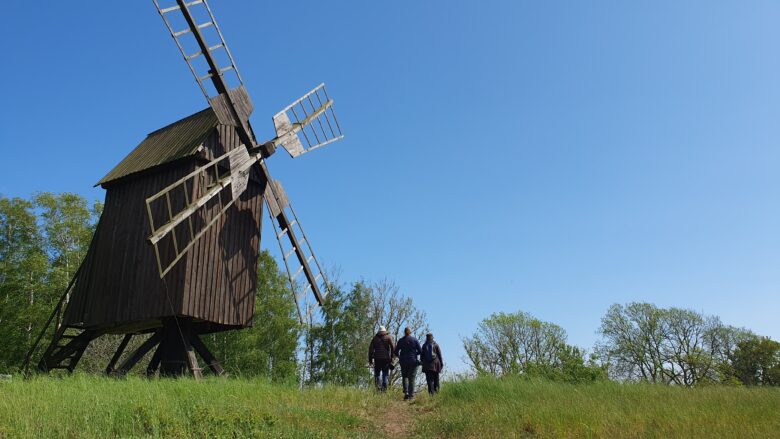This post is also available in: Dansk
True to tradition, we spent Pentecost with a bird trip to Öland in Sweden. Again our focus were the southern part of the island, from Färjestaden to Ottenby – Öland’s Södra Udde. We arrived Thursday evening before Pentecost and thus had three full days on the island before driving back home Monday afternoon.
On part of this year’s trip, we were joined by some of our friends, and we felt completely at home when we visited Sockerbruksdammarna – and finally, we were on a twitch without realizing it!
Read on and get a taste of some of our experiences from this year’s trip to Öland.

Company at Öland
It is not a surprise, that there are quite a few people on Öland during Pentacost. But this year, the large number of birdwatchers – especially on Saturday and Sunday – was almost crazy! We were this year ourselves joined by some of our friends. Together with Ole, we visited Alvaret and a number of good birding sites, including Beijershamn, Bårby Kärr, and Albrunna Kalkbrud.
In the following days we spent many good hours in the field with Nanna and Martin. We visited Södra Udde and Ottenby Lund, where both Hvidhalset and Little Flycatcher were very cooperative. Several other good biding locations were covered. And this year Uffe really had an opportunity to guide, show and tell about the birds we saw along the way.

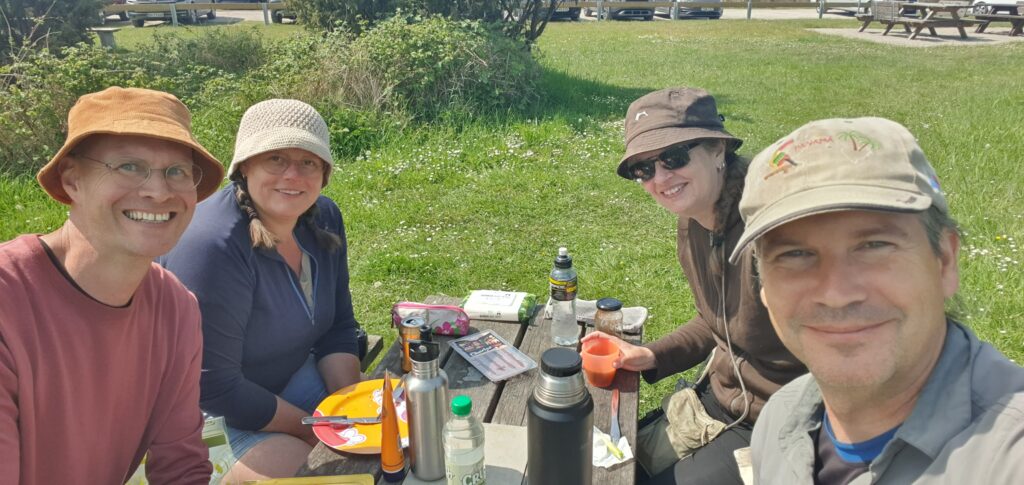
The article continues below this Advertisement
Sockerbruksdammarna
There are some classic Öland birding locations we visit every year – e.g. Ottenby Lund and Öland’s Södra Udde, both are a must! But every year we visit “new” locations and some of them prove to be worth visiting again. The new locations will be added to the list, so we remember to visit them next year.
Last year, it was Beijershamn that made the list (read Phalaropes, White-winged Black Tern and a failed harbor project on Öland). This year, Sockerbruksdammarna at Mörbylånga became one of the new locations.
Sockerbruksdammarna is Öland’s answer to the Jordbasinnerne at Møn – a man-made bird and nature site. Just like the pools on Møn, some ponds are created from deposited soil from the washing of sugar beets. Today the sugar factory is closed and the area functions as a recreational area (you can play Freespee golf) with a rich and exciting birdlife.

There are four pools and from the ramparts, you can look into them. Three of them have open water with varying amounts of vegetation, and a fourth is dry. Centrally, between the four pools, a fine birdwatching tower has been erected. From that, you can get an overview of the area. We stopped by a few times – first with Ole and later with Nanna and Martin. Both times we saw a pair of Slavonian Grebe. We also heard and saw a Marsh Warbler, which was entertaining us with its many imitations of other birds. But, unfortunately, we did not hear a Great Reed Warbler that had been heard a few days before.
The Sockerbruksdammarna is definitely worth a visit and since the ICA is right next door, a visit can be combined with shopping if you need some supplies.
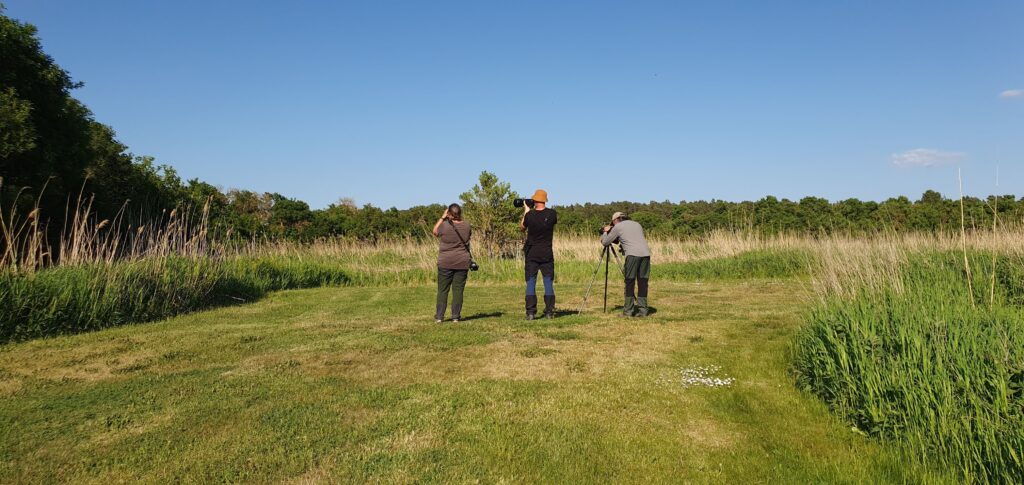
On a twitch without knowing it
Saturday afternoon we drove to Sebybadet, to look at waders at Sebyläge and Gammalsby Sjömarker. At the parking lot, orchids are abundant and you’ll find other interesting plants.
When we approached Sebybadet, we sensed that quite a few others had the same idea! We thought that there were a lot of people on Öland – not just bird watchers – but there were quite a few who found their way to Sebybadet. We arrived at the same time as three other cars with birders, who almost jumped out of the cars. The parking lot was pretty much full of cars and tourists and their big motorhomes!
I hadn’t noticed that a hit (a rare bird) had been reported, but we hurried to follow the flow of birders south. Along the way, we overheard some talking and the mentioning of the words phalarope and still there. With the scope over my shoulder, I scrolled down over the latest reports on the Band channel Ölandsskðarna, and now saw that a Red-necked Phalarope had indeed been reported – but for the location Gammalsbyören, which is a “stone reef” immediately south of Sebybadet.
Amidst birdwatchers and a herd of confused calves, we quickly found the phalarope – it was a female foraging close to the shore, and together with a flock of Dunlin and at least four Broad-billed Sandpipers – cool!
After enjoying the birds for a while, we were amused that we had ended up on a twitch without realizing it. But it didn’t matter, because Nanna and Martin got a nice new species for their lists.

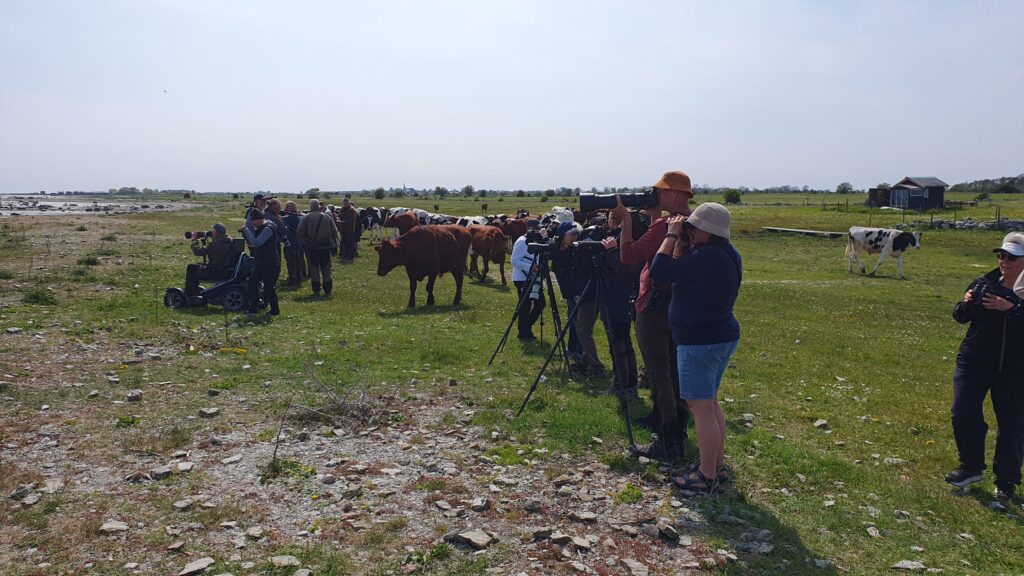
A surprise at Alvaret
After the surprise with the phalarope and some botanizing, we needed a more peaceful place – without a lot of people. The Alvar covers a large area and it should be possible to find a quiet place.
We found a spot along Torngårdsvägen, which connects Tornsgård and Södra Möcleby, and parked. An old dirt road looked just so interesting that we, by foot, just had to follow it north – and out onto Alvaret.
It was dry, but we passed a couple of old “quarry lakes” where there was still some water. This meant that we saw Ringed Plovers and Redshanks – and not only the numerous Northern Wheatear. In a thicket we “tried” to turn some Whitethroat and Lesser Whitethroat into a Barred Warbler – we didn’t succeed!
Eagles
Suddenly, Martin spotted a raptor far away in the heat flicker. The white tail with a black terminal band could be clearly seen. Rough-legged Buzzard was my immediate thought – but a very dark specimen. A species that at this time of the year should be in the Swedish mountains! The bird started soaring and take advantage of the thermals. The distance was very long, and the light very bright. The heat flicker certainly didn’t help, but we talked about how big it seemed – was it actually a young Golden Eagle we were looking at!?
At some point, we realized that we just had to “let that bird fly”, and started to move on. At the same time, an eagle-sized bird raptor took off from some trees further ahead. Sea eagle! I exclaimed loudly as the eagle flew away from us with powerful wing beats. It gained a little height and turned around – and the white tail with a black terminalband became visible – “No, it’s a Golden Eagle!”.
This time we had no doubts. We followed the eagle through binoculars. When it a little later reached the bird from before and they were soaring together, we were sure, that both birds actually were Golden Eagles! A cool surprise that we had not expected at all.
Subsequently, based on our “documentary photos” confirmed that the two raptors were Golden Eagles.

The birds
This year Pentecost fell at the end of May. The year before, it was at the beginning of June – around the Danish Grundlovsdag (Constitution Day). Therefore, it was also interesting, if temporal difference had an effect on the occurrence of birds – and especially the occurrence of orchids.
In terms of birds, there was not immediately any noticeable difference, perhaps only that the spring migration of the birds was still going on – especially of Brent Geese and a smaller “fall” of passerines. In terms of time, the difference was also only a week’s time, so the current weather conditions should have a greater significance.
In any case, we had many nice birding experiences, and the tour list included at least 112 bird species (we did not “enter” all the species we saw). Some of the more exciting species – seen from Danish eyes – were the Slavonian Grebe (Podiceps auritus), Red-necked Phalarope (Phalaropus lobatus), Little Gull (Hydrocoloeus minutus), Golden Eagle (Aquila chrysaetos), Montagu’s Harrier (Circus pygargus), Eurasian Golden Oriole (Oriolus oriolus), Collared Flycatcher (Ficedula albicollis), and Common Rosefinch(Carpodacus erythrinus). In addition, we also saw Red-backed Shrikes, Wheatears, and Whinchats.
En ikke udtømmende oversigt over turens fugleobservationer kan ses via dette link til eBird: Öland – Pinsen 2023.
The orchids
It was already very dry at Öland. At Alvaret, on the first evening, we met a woman from Kalmar who was photographing flowers. She was not at all satisfied, because there were always “withered leaves” in the background. She was very worried and said that people were talking about the conditions were already reminding them of the drought in 2018!
But there were still many plants and flowers to enjoy – and we saw many more orchids than the year before! The most numerous was the Early purple orchid (Orchis mascula), which flowered in large, dense stands in several places. There were also a number of “Krutbrännere” – in English Burnt Orchid (Neotinea ustulata), Green-winged Orchid (Anacamptis morio) and Common Twayblade (Neottia ovata). And this year we also found Elderberry Orchid (Dactylorhiza sambucina) – which in Swedish is called “Adam and Eve”.
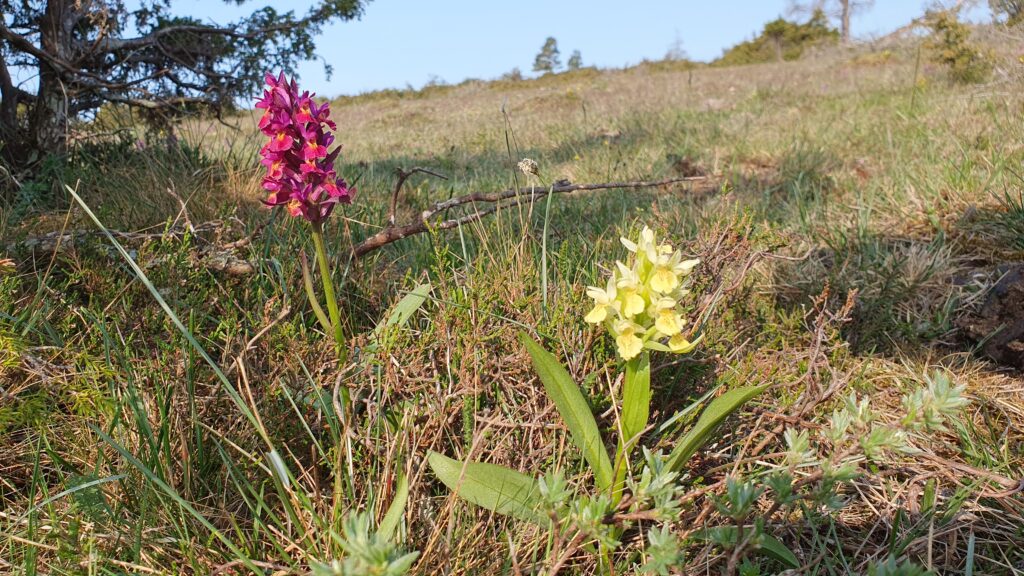
All photos, video and audio recordings © Bente Steffensen & Uffe Damm Andersen, unless otherwise stated.

